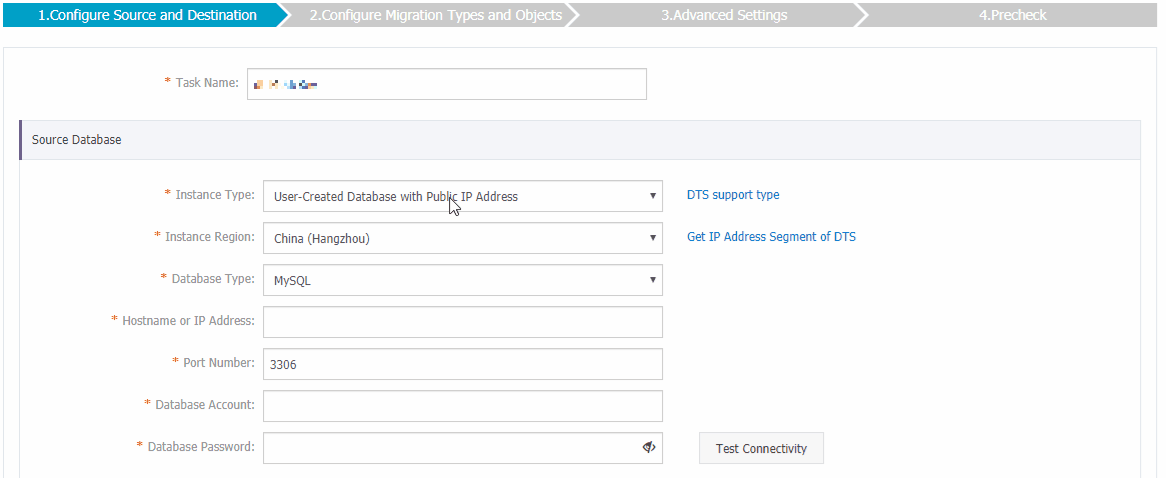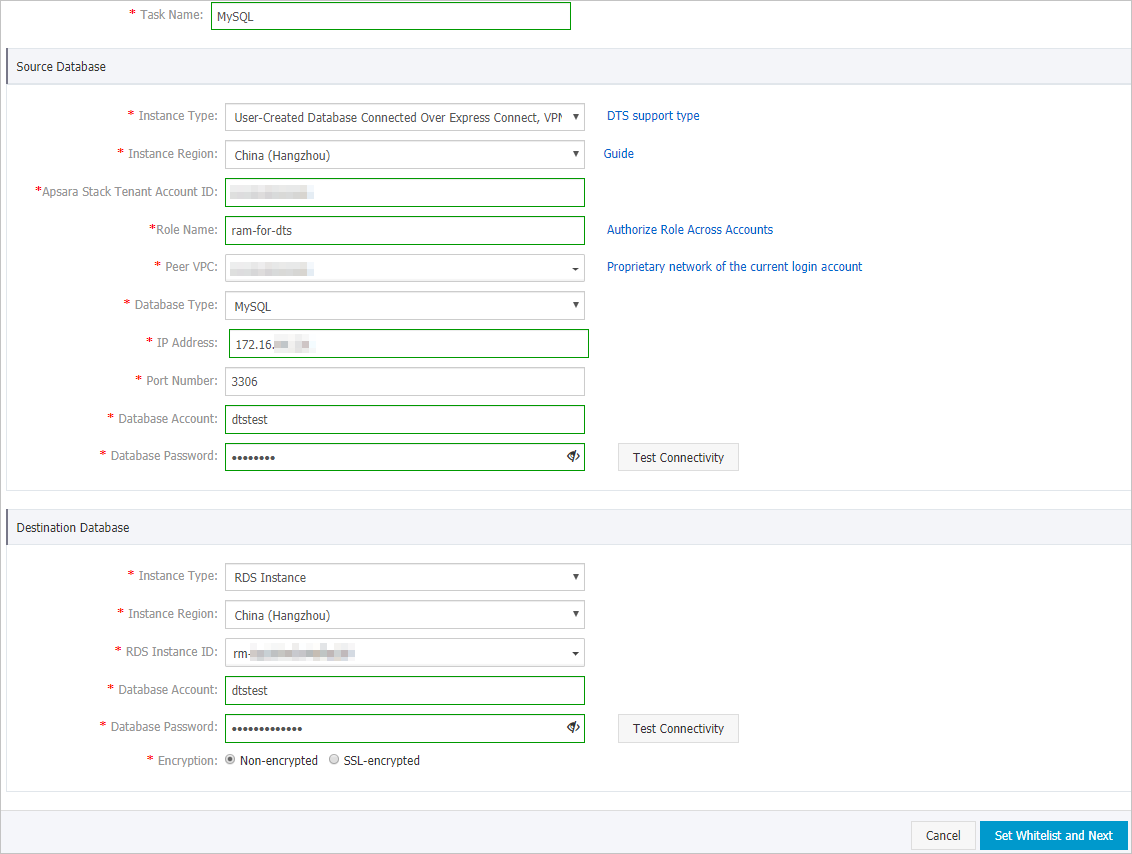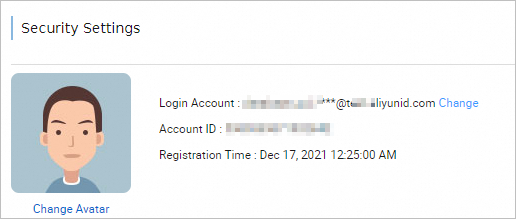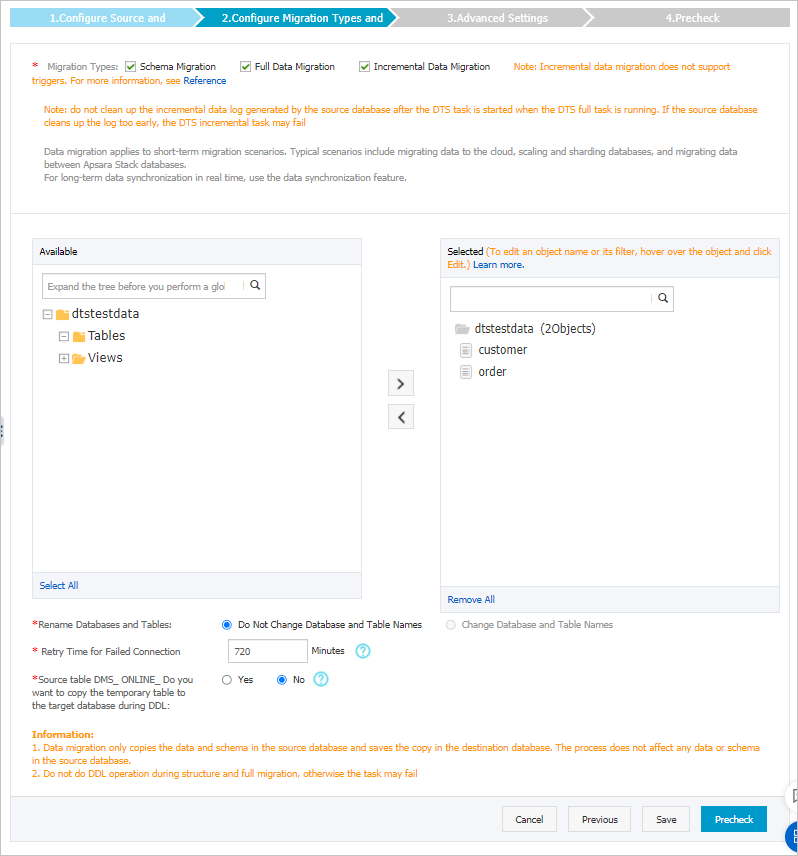This topic describes how to migrate data from a self-managed MySQL instance that is connected over an Express Connect circuit, a VPN gateway, or a Smart Access Gateway (SAG) instance to an ApsaraDB RDS for MySQL instance by using Data Transmission Service (DTS). In this scenario, the Express Connect circuit, VPN gateway, or SAG instance and the destination ApsaraDB RDS for MySQL instance belong to different Alibaba Cloud accounts. DTS supports schema migration, full data migration, and incremental data migration. When you migrate data from a self-managed MySQL instance, you can select all the supported migration types to ensure business continuity.
Prerequisites
The engine version of the self-managed MySQL database is 5.1, 5.5, 5.6, 5.7 or 8.0.
The available storage of the ApsaraDB RDS for MySQL instance is larger than the total size of the data in the self-managed MySQL instance.
The on-premises network to which the self-managed MySQL instance belongs is connected to an Alibaba Cloud virtual private cloud (VPC) over an Express Connect circuit, a VPN gateway, or an SAG instance. The Express Connect circuit, VPN gateway, or SAG instance and the destination ApsaraDB RDS for MySQL instance belong to different Alibaba Cloud accounts.
NoteFor more information about access methods, see Preparation overview.
Background information
The data center that hosts your instance is connected to Alibaba Cloud over an Express Connect circuit, a VPN gateway, or an SAG instance. You want to migrate data from the self-managed MySQL instance to an RDS instance across different Alibaba Cloud accounts over a VPC. The following figure shows the architecture for this scenario.

Limits
- DTS uses read and write resources of the source and destination databases during full data migration. This may increase the loads of the database servers. If the database performance is unfavorable, the specification is low, or the data volume is large, database services may become unavailable. For example, DTS occupies a large amount of read and write resources in the following cases: a large number of slow SQL queries are performed on the source database, the tables have no primary keys, or a deadlock occurs in the destination database. Before you migrate data, evaluate the impact of data migration on the performance of the source and destination databases. We recommend that you migrate data during off-peak hours. For example, you can migrate data when the CPU utilization of the source and destination databases is less than 30%.
- The tables to be migrated in the source database must have PRIMARY KEY or UNIQUE constraints and all fields must be unique. Otherwise, the destination database may contain duplicate data records.
- DTS uses the
ROUND(COLUMN,PRECISION)function to retrieve values from columns of the FLOAT or DOUBLE data type. If you do not specify a precision, DTS sets the precision for the FLOAT data type to 38 digits and the precision for the DOUBLE data type to 308 digits. You must check whether the precision settings meet your business requirements. - DTS automatically creates a destination database in the ApsaraDB RDS for MySQL instance. However, if the name of the source database is invalid, you must manually create a database in the ApsaraDB RDS for MySQL instance before you configure the data migration task. Note For more information about the database naming conventions of ApsaraDB RDS for MySQL databases and how to create a database, see Create a database for an ApsaraDB RDS for MySQL instance.
- If a data migration task fails, DTS automatically resumes the task. Before you switch your workloads to the destination instance, stop or release the data migration task. Otherwise, the data in the source database overwrites the data in the destination instance after the task is resumed.
Billing rules
Migration type | Task configuration fee | Internet traffic fee |
Schema migration and full data migration | Free of charge. | Charged only when data is migrated from Alibaba Cloud over the Internet. For more information, see Billing overview. |
Incremental data migration | Charged. For more information, see Billing overview. |
Migration types
- Schema migration
DTS migrates the schemas of the required objects to the destination instance. DTS supports schema migration for the following types of objects: table, view, trigger, stored procedure, and function.
Note- During schema migration, DTS changes the value of the SECURITY attribute from DEFINER to INVOKER for views, stored procedures, and functions.
- DTS does not migrate user information. To call a view, stored procedure, or function of the destination database, you must grant the read and write permissions to INVOKER.
- Full data migration DTS migrates historical data of the required objects from the self-managed MySQL database to the destination database in the ApsaraDB RDS for MySQL instance.Note During full data migration, concurrent INSERT operations cause fragmentation in the tables of the destination database. After full data migration is complete, the tablespace of the destination database is larger than that of the source database.
- Incremental data migration
After full data migration is complete, DTS retrieves binary log files from the self-managed MySQL database. Then, DTS synchronizes incremental data from the self-managed MySQL database to the destination ApsaraDB RDS for MySQL instance. Incremental data migration allows you to ensure service continuity when you migrate data from a self-managed MySQL database to Alibaba Cloud.
SQL operations that can be synchronized during incremental data migration
| Operation type | SQL statement |
| DML | INSERT, UPDATE, DELETE, and REPLACE |
| DDL |
|
Permissions required for database accounts
| Database | Schema migration | Full data migration | Incremental data migration |
| Self-managed MySQL database | The SELECT permission | The SELECT permission | The REPLICATION SLAVE, REPLICATION CLIENT, SHOW VIEW, and SELECT permissions |
| ApsaraDB RDS for MySQL instance | Read and write permissions | Read and write permissions | Read and write permissions |
For more information about how to create an account and grant permissions to the account, see the following topics:
- Self-managed MySQL databases: Create an account for a self-managed MySQL database and configure binary logging
- ApsaraDB RDS for MySQL instance: Create an account on an ApsaraDB RDS for MySQL instance and Modify the permissions of a standard account on an ApsaraDB RDS for MySQL instance
Before you begin
Create an account for a self-managed MySQL instance and configure binary logging.
Log on to the Alibaba Cloud Management Console by using the Alibaba Cloud account that owns the Express Connect circuit. Authorize DTS to access the network that is connected over Express Connect. For more information, see Connect a data center to DTS by using VPN Gateway.
Create a RAM role and authorize the RAM role to access the resources of the Alibaba Cloud account to which the Express Connect circuit belongs. For more information, see Configure RAM authorization for data migration or synchronization from a self-managed database in a VPC across different Alibaba Cloud accounts.
Procedure
Log on to the DTS console by using the Alibaba Cloud account to which the RDS instance belongs.
Note If you are redirected to the Data Management (DMS) console, you can click the icon in the lower-right corner to go to the previous version of the DTS console.
icon in the lower-right corner to go to the previous version of the DTS console.- In the left-side navigation pane, click Data Migration.
- At the top of the Migration Tasks page, select the region where the destination cluster resides.
- In the upper-right corner of the page, click Create Migration Task.
Select User-Created Database Connected Over Express Connect, VPN Gateway, or Smart Access Gateway as the instance type. Then, click VPC under other Alibaba cloud accounts.

Configure the source and destination databases.

Section
Parameter
Description
N/A
Task Name
The task name that DTS automatically generates. We recommend that you specify a descriptive name that makes it easy to identify. You do not need to specify a unique task name.
Source Database
Instance Type
The access method of the source instance. Select User-Created Database Connected Over Express Connect, VPN Gateway, or Smart Access Gateway.
Instance Region
The region of the VPC that is connected to the self-managed MySQL instance.
Alibaba Cloud Account ID
The ID of the Alibaba Cloud account of the self-managed instance.
NoteTo obtain the ID of the Alibaba Cloud account, you must log on to the Security Settings console by using this account. The Account ID is displayed on the Security Settings page.

Role
The name of the RAM role that you created before you configure the data migration task. For more information, see Before you begin.
Peer VPC
The ID of the VPC that is connected to the self-managed MySQL instance.
Database Type
The type of the source instance. In this example, MySQL is selected.
IP Address
The endpoint that is used to access the self-managed MySQL instance.
Port Number
The service port number of the self-managed MySQL instance. Default value: 3306.
Database Account
The account of the self-managed MySQL instance. For more information about the permissions that are required for the account, see Permissions required for database accounts.
Database Password
The password of the database account.
NoteAfter you specify the information about the source database, you can click Test Connectivity next to Database Password to check whether the information is valid. If the information is valid, the Passed message appears. If the Failed message appears, click Check next to Failed. Then, modify the information based on the check results.
Destination Database
Instance Type
The instance type of the RDS instance. In this example, RDS Instance is selected.
Instance Region
The region in which the RDS instance resides.
RDS Instance ID
The ID of the RDS instance.
Database Account
The database account of the RDS instance. For more information about the permissions that are required for the account, see Permissions required for database accounts.
Database Password
The password of the database account.
NoteAfter you specify the information about the RDS instance, you can click Test Connectivity next to Database Password to check whether the information is valid. If the information is valid, the Passed message appears. If the Failed message appears, click Check next to Failed. Then, modify the information based on the check results.
Encryption
Specifies whether to encrypt the connection. Select Non-encrypted or SSL-encrypted based on your business requirements. If you select SSL-encrypted, you must enable SSL encryption for the RDS instance before you configure the data migration task. For more information, see Configure SSL encryption for an ApsaraDB RDS for MySQL instance.
NoteThe Encryption parameter is available only for regions in the Chinese mainland and the China (Hong Kong) region.
In the lower-right corner of the page, click Set Whitelist and Next.
Warning If the CIDR blocks of DTS servers are automatically or manually added to the whitelist of the database or instance, or to the ECS security group rules, security risks may arise. Therefore, before you use DTS to migrate data, you must understand and acknowledge the potential risks and take preventive measures, including but not limited to the following measures: enhance the security of your username and password, limit the ports that are exposed, authenticate API calls, regularly check the whitelist or ECS security group rules and forbid unauthorized CIDR blocks, or connect the database to DTS by using Express Connect, VPN Gateway, or Smart Access Gateway.- Select the migration types and the objects to be migrated.

Setting Description Select the migration types - To perform only full migration, select Schema Migration and Full Data Migration.
- To ensure service continuity during data migration, select Schema Migration, Full Data Migration, and Incremental Data Migration.
Note If Incremental Data Migration is not selected, we recommend that you do not write data to the source database during data migration. This ensures data consistency between the source and destination databases.Select the objects to be migrated Select one or more objects from the Available section and click the
 icon to move the objects to the Selected section. Note
icon to move the objects to the Selected section. Note- You can select columns, tables, or databases as the objects to be migrated.
- By default, after an object is migrated to the destination database, the name of the object remains unchanged. You can use the object name mapping feature to rename the objects that are migrated to the destination database. For more information, see Object name mapping.
- If you use the object name mapping feature to rename an object, other objects that are dependent on the object may fail to be migrated.
Specify whether to rename objects You can use the object name mapping feature to rename the objects that are migrated to the destination instance. For more information, see Object name mapping. Specify the retry time for failed connections to the source or destination database By default, if DTS fails to connect to the source or destination database, DTS retries within the next 720 minutes (12 hours). You can specify the retry time based on your needs. If DTS reconnects to the source and destination databases within the specified time, DTS resumes the data migration task. Otherwise, the data migration task fails. Note When DTS retries a connection, you are charged for the DTS instance. We recommend that you specify the retry time based on your business needs. You can also release the DTS instance at your earliest opportunity after the source and destination instances are released.Specify whether to copy temporary tables to the destination database when DMS performs online DDL operations on the source table If you use Data Management (DMS) to perform online DDL operations on the source database, you can specify whether to migrate temporary tables generated by online DDL operations. - Yes: DTS migrates the data of temporary tables generated by online DDL operations. Note If online DDL operations generate a large amount of data, the data migration task may be delayed.
- No: DTS does not migrate the data of temporary tables generated by online DDL operations. Only the original DDL data of the source database is migrated. Note If you select No, the tables in the destination database may be locked.
- In the lower-right corner of the page, click Precheck. Note
- Before you can start the data migration task, DTS performs a precheck. You can start the data migration task only after the task passes the precheck.
- If the task fails to pass the precheck, you can click the
 icon next to each failed item to view details.
icon next to each failed item to view details. - You can troubleshoot the issues based on the causes and run a precheck again.
- If you do not need to troubleshoot the issues, you can ignore failed items and run a precheck again.
- After the task passes the precheck, click Next.
- In the Confirm Settings dialog box, specify the Channel Specification parameter and select Data Transmission Service (Pay-As-You-Go) Service Terms.
- Click Buy and Start to start the data migration task.
- Schema migration and full data migration
We recommend that you do not manually stop the task during full data migration. Otherwise, the data migrated to the destination database may be incomplete. You can wait until the data migration task automatically stops.
- Schema migration, full data migration, and incremental data migration
An incremental data migration task does not automatically stop. You must manually stop the task.
Important We recommend that you select an appropriate time to manually stop the data migration task. For example, you can stop the task during off-peak hours or before you switch your workloads to the destination cluster.- Wait until Incremental Data Migration and The migration task is not delayed appear in the progress bar of the migration task. Then, stop writing data to the source database for a few minutes. The latency of incremental data migration may be displayed in the progress bar.
- Wait until the status of incremental data migration changes to The migration task is not delayed again. Then, manually stop the migration task.

- Schema migration and full data migration
Switch your workloads to the RDS instance.